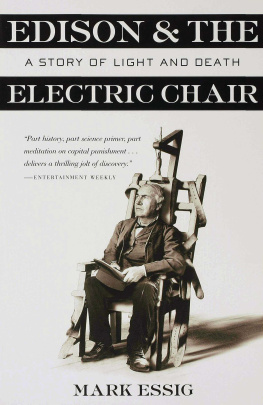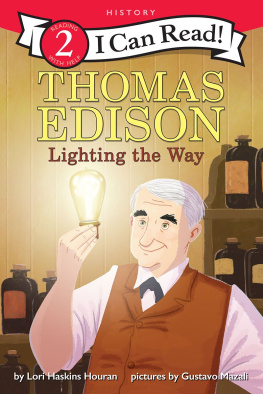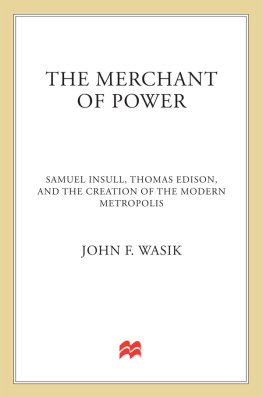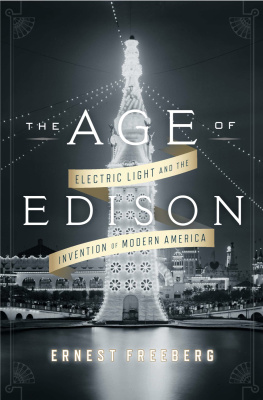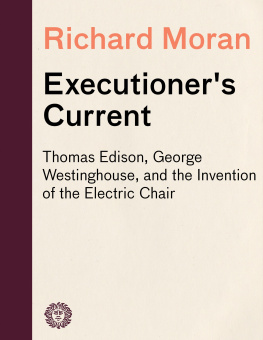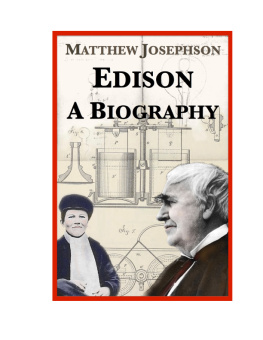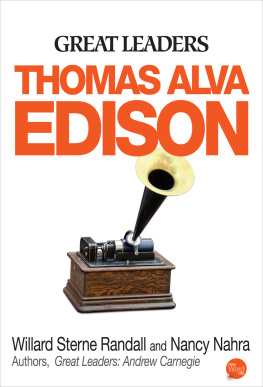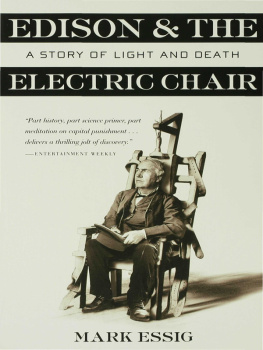Edison &
the
Electric
Chair

A Story of Light and Death
Mark Essig

Copyright 2003 by Mark Essig
All rights reserved. No part of this book may be reproduced or transmitted in any form or by any means, electronic or mechanical, including photocopying, recording, or by any information storage and retrieval system, without permission in writing from the Publisher.
First published in the United States of America in 2003 by
Walker Publishing Company, Inc. First paperback edition published in 2005.
For information about permission to reproduce selections from this book, write to Permissions, Walker & Company, 104 Fifth Avenue, New York, New York 10011
Library of Congress Cataloging-in-Publication Data
Essig, Mark Regan, 1969
Edison & the electric chair : a story of light and death / Mark Essig.
p. cm.
Includes bibliographical references and index.
eISBN: 978-0-802-71928-7
1. ElectrocutionUnited StatesHistory. 2. Edison, Thomas A. (Thomas Alva), 1847-1931. I. Title: Edison and the electric chair. II. Title.
HV8696.E87 2003
364.66dc21 2003052507
ISBN 0-8027-7710-4 (paperback)
Book design by Ralph L. Fowler
Illustrations by Martie Holmer
Book composition by Coghill Composition Company
Visit Walker & Company's Web site at www.walkerbooks.com
Printed in the United States of America
10 9 8 7 6 5 4 3 2 1
TO MY PARENTS,
DOROTHY AND JOHN ESSIG
CONTENTS
Edison & the Electric Chair
M R. EDISON, what is your callingyour profession?"
"Inventor."
"Have you devoted a good deal of attention to the subject of electricity?"
The hearing room erupted in laughter. It was a standard lawyer's question, intended to establish the qualifications of an expert witness, but it was hardly necessary in this instance. The men who packed the roomlawyers, electricians, doctors, and assorted gawkersknew very well the qualifications of the man on the stand. In 1879 Thomas Edison had invented the first practical incandescent lampthe light-bulband over the next decade he carried his light into homes and offices around the world. As the world's most celebrated electrical authority, Edison clearly had "devoted a good deal of attention to the subject of electricity."
The inventor took the question in stride. "Yes, sir," he replied.
The date was July 23,1889, and the lawyer asking the questions was William Poste, deputy attorney general of New York State. Edison was forty-two years old, his dark hair streaked with white, face smooth-shaven, gray eyes sparkling. In his black suit and white tie, Edison had the aspect, one reporter remarked, of "a benignant clergyman of middle age." No stranger to the American legal system, he sat thoroughly at ease in the witness chair. Inventing was a cutthroat business, and Edison spent a great deal of time dealing with lawyerssuing other companies for stealing his patents, getting sued in turn for stealing theirs. Invention, he might have said, was 1 percent inspiration and 99 percent litigation.
The hearing on this day in July, though, was not concerned with patents. It had to do with a murder case.
"What amount of electrical energy," Poste continued, "do you think would be sufficient to produce instant, painless, death in all cases?"
"One thousand volts," Edison said.
"What experiments have you observed in your laboratory bearing upon that question?"
"Only of horses and dogs."
Edison referred to a series of tests that had taken place over the previous year at his New Jersey laboratory. The inventor's assistants attached electrodes to dogsabout two dozen in all, bought at a quarter a head from neighborhood boysand killed them with powerful jolts of electricity. Six calves and two horses also died in the experiments.
"Now, Mr. Edison," the attorney said, "in your opinion, can an electrical current be applied to the human body by artificial means in such a manner as to produce death in every case?"
"Yes, sir."
"Instant death?"
"Yes, sir."
"Painless?"
"Yes, sir."
A year and a half earlier New York State had abolished hanging and decreed that condemned criminals would be executed with electricity. The first murderer condemned under the new law filed an appeal, claiming that electrical execution was a cruel and unusual punishment and therefore unconstitutional. A judge ordered hearings to collect expert testimony on the matter, and Edison agreed to testify in support of the new method.
Electricity had long been considered a mysterious, miraculous forcetelegraph operators sent it zipping along slender copper wires, showmen amused fairgoers by giving them mild electric shocks, and doctors claimed that the current could cure illness and revive victims of drowning or suffocation. It had even been used to kill: In the 1750s Benjamin Franklin slaughtered chickens and turkeys with static electricity.
But using electricity to execute criminals was unprecedented. One newspaper declared that state officials had been swept up in an electrical craze and were "merely endeavoring to show that there was no end to the wonders of electricity."
Although in 1887 Edison had said he would "join heartily in an effort to totally abolish capital punishment," a year later he became the most powerful advocate of this new method of scientific killing. Like other defenders of the electrical execution law, he claimed that a powerful current would be far more humane than hanging.
Edison's critics, however, believed there was more to the story. In the hallways outside the hearing room and in the pages of newspapers and electrical journals, insiders alleged that Edison's support for electrocution was motivated by a devious scheme to gain control of the electrical industry; that an Edison competitor was spending tens of thousands of dollars to defeat the electrocution law and foil Edison's plans; that the convicted murderer whose life was on the line had become a pawn in a bitter industrial struggle.
If any of these rumors were true, Edison did not let on. Killing with electricity was simply "a good idea," he said. "It will be so lightning like quick that the criminal can't suffer much."
T HE ANCIENT GREEKS were the first to record the observation that amber, after being rubbed, attracted bits of straw or cloth. Around 1600 the Englishman William Gilbert noted that materials such as diamond and glass shared amber's attractive qualities. He coined a new word, electric, based on elektron, Greek for amber. An electric was a substance that, when rubbed, drew light objects to itself; electricity was the property shared by these substances.
After Gilbert the study of electricity languished for a century or so until it was taken up by members of London's Royal Society, a new association devoted to the study of the natural world. Using hollow glass tubes thirty inches long and one inch in diameter, Royal Society members produced the strongest electrical effects ever witnessed. In 1729 Stephen Gray, an experimenter with the society, corked the ends of his tube to keep dust from being sucked inside. After rubbing the glass, he noticed to his surprise that feathers were attracted to the cork as well as to the glass. The "attractive Virtue," as he put it, had been "communicated" from the glass to the cork. Curious to see how far this communication would extend, Gray attached ordinary thread to the cork, tied a shilling to the string, and found that the coin attracted feathers. He extended the string and tied on more objectsa piece of tin, an iron poker, a copper teakettle, various vegetablesand found that all became electrified. Gray attached thirty-two feet of thread to the corked end of the glass tube, tied a billiard ball to the other end of the string, and dangled it out a window. When he rubbed the glass, he found that the billiard ball still proved attractive.

